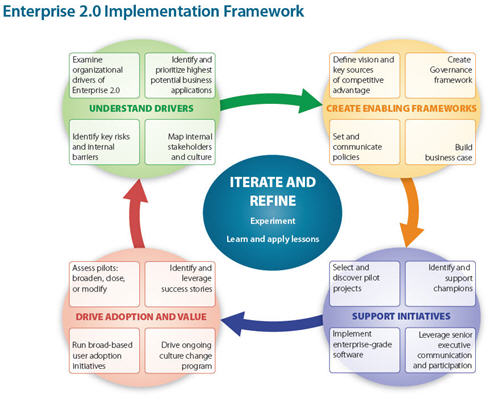8 Guiding Principles for Pilot Programs: A Key for Enterprise 2.0
In my Implementing Enterprise 2.0 report I put Iterate and Refine at the center of the Enterprise 2.0 Implementation Framework.
One of the most critical elements of this principle is the ability to establish and run effective pilot programs.
Below is an excerpt from Chapter 17 of Implementing Enterprise 2.0 on Pilots, which describes 8 guiding principles for pilot programs.
GUIDING PRINCIPLES FOR PILOTS
While there are no hard and fast rules for establishing successful pilots, eight guiding principles that should be kept in mind are:
“It is reasonably cheap and easy to get a pilot up and running to evaluate how successful a new Technology will be. Fail fast, fail cheap. Set things up as pilots and pick up the lessons.”
CIO, large property developer
1. Select fertile ground.
Pilots often establish the tone for how broader initiatives are received across the organization. Stories – both positive and negative – about the success of pilots often filter out very widely. A successful pilot can easily take a life of its own as others hear about the benefits and actively want to apply them in their own work. Failures can often be referred to across the organization as reasons why related initiatives will not succeed. While you can never expect all pilots to be successful, maximize chances of success by selecting the most promising projects and the best team, and make it easy for them to identify value.
2. The pilot team is critical.
Perhaps the single most important success factor in Enterprise 2.0 pilots is the people involved. While there are a number of criteria in selecting a pilot team (for more details see below), the single most important attribute is enthusiasm. Given that these technologies require new approaches to working and communicating, uptake and resultant benefits will depend substantially on the degree of use and experimentation during the pilot.
3. Design around business applications or benefits NOT tools.
Far too often organizations decide to trial specific tools such as wikis and blogs without having a clear idea of why they are doing so. In the majority of these cases pilots fail to gain traction or result in clear benefits. Pilots should be designed either to create specific benefits such as streamlined processes and faster outcomes (which will provide clear measures for the pilot’s success), or an application such as project management or creating better sales forecasts.
4. Define scope but encourage experimentation.
In establishing pilot projects, a balance needs to be struck between having clarity on the intentions and scope of the pilot, and allowing experimentation that may uncover even more valuable uses and applications. A definition of pilot scope includes the immediate objectives, participants, and timeline for review. However if variations on the intended activity, or even entirely different approaches, seem to offer potential business value, these should be encouraged. Remember that experimentation is often the source of much of the value of Enterprise 2.0 implementations.
5. Design the pilot to learn useful lessons and expand.
Pilots are established with the primary intention of demonstrating value so that they can be applied more broadly across the organization. However even if the pilot is very successful, it should not necessarily be implemented in the same way for future roll-outs. And if the pilot is not seen to be successful, there may be even more useful lessons on how to improve or refine subsequent initiatives. As such, there need to be specific systems to capture lessons during and at the conclusion of the pilot.
6. Provide training and guidance.
If no training is provided on the use of a new tool, it should not be surprising if it is not used or used well. This can be done in many formats, including brief online learning sessions. It is possible to setup pilots so that usage guidelines and recommendations are provided at first login, and regularly during the process of the trial.
7. Create visibility.
In many cases you will want pilots to be visible outside the pilot group, in order to attract participation, generate demand in the rest of the organization, and stimulate ideas for other applications. For example providing reference materials on IT support or HR policies creates broad visibility for new approaches. However in some cases you may choose to keep pilots less visible if there are greater risks of failure or active experimentation by a small team.
“The earlier you determine when something should be killed, the better.”
Charlie Beaver, vice-president, Booz Allen Hamilton
8. Monitor progress and cut or expand.
It is a mistake to set up a series of pilots without subsequently assessing progress. That can be easier with Enterprise 2.0 tools than with some other technologies, given the very low costs of the tools. The mantra of “fail fast, fail cheap” is immensely relevant here. Specific timeframes – usually measured in months – for the pilots need to be established at the outset. Success needs to be assessed both in terms of the initial objectives and/or any other value that has been created in the process of the project (see principle 5 above). Decisions must be made on whether to continue, expand, discontinue, or change the pilot.

